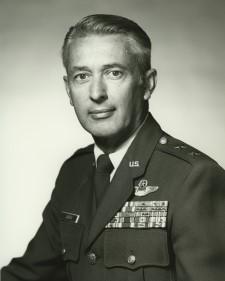Major General Gerald D Larson is deputy chief of staff, air, Headquarters Allied Forces Northern Europe, Oslo, Norway.
General Larson was born in 1932, in Jamestown, N.Y., and graduated from Jamestown High School and Jamestown Community College. The general earned his bachelor’s degree through the Bootstrap program at the University of Nebraska, Omaha, in 1963. He completed the Air War College at Maxwell Air Force Base, Ala., in 1973, concurrently earning his master’s degree from Troy (Ala.) State University.\
Enlisting in the U.S. Air Force in September 1953, he was commissioned through the aviation cadet program in February 1955. His first operational assignment was as a squadron pilot flying F-86s at Osan Air Base, South Korea. General Larson was then assigned to tactical fighter squadrons at Bunker Hill Air Force Base, Ind., and England Air Force Base, La.
In October 1960 he was selected as a demonstration pilot with the 4520th Air Demonstration Squadron (the Thunderbirds), Nellis Air Force Base, Nev. He flew the solo position and later initiated the team’s double solo routine in the F-100C.
Thunderbirds F-100 Super Sabre era
The Thunderbirds’ aircraft were [again] changed in June 1956, to the F-100C Super Sabre, which gave the team supersonic capability. This switch was accompanied by a relocation of their headquarters to Nellis AFB, NV on 1 June because of maintenance and logistical difficulties of basing the F-100s at Luke, with their first show after the move being held on 23 June. It also signaled a shift in their performance routine—for example, the Cuban 8 opening routine was dropped, and emphasis was placed on low, screaming flyovers and demonstrations of takeoff performance. For a time, if the show’s sponsor permitted it, the pilots would create a “sonic boom;” this ended when the FAA banned supersonic flight over the continental United States. The move to Nellis also resulted in the first assignment of buildings and hangar space to the team.
…In 1961, the team was compelled to discontinue the vertical bank maneuver due to an FAA regulation prohibiting aerobatics that pointed the nose of the aircraft toward the crowd. The year 1962 saw the introduction of dual solo routines, and the Thunderbirds went on their first European deployment in 1963, the year after the disbanding of the “Skyblazers.“
Following completion of his Bootstrap academic program in March 1963 at the University of Omaha, General Larson was assigned to the Air Force’s first F-4 unit at MacDill Air Force Base, FL.
The general attended the Aerospace Research Pilot School from August 1964 to September 1965. He was then assigned as an operational test and evaluation project officer with the Tactical Fighter Weapons Center at Nellis Air Force Base. During this assignment, he performed temporary duty in Thailand with the 555th Tactical Fighter Squadron at Ubon Royal Thai Air Force Base. In July 1968 he became an operations staff officer with the 1137th Special Activities Squadron, Washington, D.C. General Larson returned to Ubon Royal Thai Air Force Base in 1971 and served as operations officer and later as commander of the 435th Tactical Fighter Squadron.
After graduation from the Air War College in July 1973, he was assigned as chief of maintenance, 86th Tactical Fighter Wing, Ramstein Air Base, Germany. In February 1974 he transferred to the 81st Tactical Fighter Wing at Royal Air Force Station Bentwaters, England, as deputy commander for operations and later as vice commander and commander of the wing. He took command of the 20th Tactical Fighter Wing at Royal Air Force Station Upper Heyford in June 1977 and then became inspector general for the U.S. Air Forces in Europe at Ramstein Air Base in April 1978. He was named the command’s assistant deputy chief of staff for operations and intelligence in June 1979.
In June 1980 he took command of the Strategic Air Command’s largest flying division, the 45th Air Division at Pease Air Force Base, N.H. In July 1982 General Larson was assigned as commander, Air Force Inspection and Safety Center, Norton Air Force Base, Calif. He assumed his present position in July 1984.
The general is a command pilot with more than 6,700 flying hours and 235 combat missions. His military decorations and awards include the Silver Star, Legion of Merit, Distinguished Flying Cross with three oak leaf clusters, Meritorious Service Medal, Air Medal with 25 oak leaf clusters and Air Force Commendation Medal with two oak leaf clusters.
He was promoted to major general June 1, 1982, with the date of rank Aug. 1, 1978.
(source: Https://www.af.mil/About-Us/Biographies/Display/Article/106434/major-general-gerald-d-larson/)








